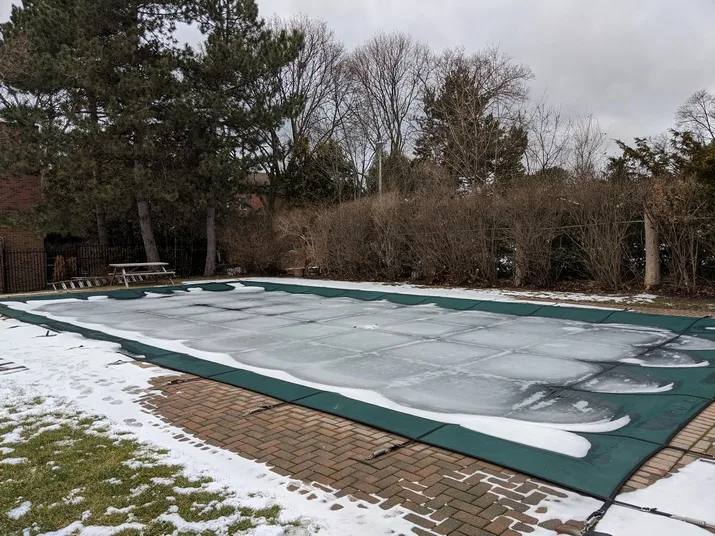Table of ContentsShow
Check and Adjust pH and Chlorine Levels Regularly
One of the most important aspects of pool maintenance is checking and adjusting the pH and chlorine levels of your pool water regularly. The ideal pH range is 7.2 to 7.8, and the ideal chlorine level is 1 to 3 parts per million (ppm). You can use a pH test kit and a chlorine test kit to measure these levels.
If the pH is too high or too low, you can use a pH balancer to correct it. If the chlorine level is too low, you can add more sanitizer (chlorine, bromine, or salt) to the pool. On the other hand, if the chlorine level is too high, you can reduce it by adding water or using a chlorine neutralizer.
To adjust the pH level of your pool water, you will need to add either a base (such as sodium carbonate or sodium bicarbonate) or an acid (such as muriatic acid) to raise it up or lower it down respectively4. You should always wear protective gloves and goggles when handling chemicals and follow the safety precautions on the label. To use them correctly:
- For raising the pH level: Add about 1/4 cup of base per 10 gallons of water until you reach the desired reading on the test strip.
- For lowering the pH level: Add about 1/4 cup of acid per 10 gallons of water until you reach the desired reading on the test strip.
- Wait at least an hour before testing again to allow any changes to take effect.
- Repeat this process until you reach the ideal pH range for pools.
Shock Your Pool Regularly
Shocking your pool is an essential step in pool maintenance. This process involves adding a large dose of chlorine or non-chlorine shock to the pool to kill bacteria, algae, and organic contaminants. It is recommended to shock your pool at least once a month, or more often if the pool is heavily used or exposed to rain, wind, or debris.
When shocking your pool, it is important to follow the manufacturer’s instructions on how much shock to use per gallon of water. Additionally, you should avoid swimming in the pool until the chlorine level drops below 3 ppm.
Prevent Algae Growth
Algae can quickly turn your pool water green, cloudy, or slimy. To prevent algae growth, especially during warm weather or rainy seasons, it is important to use an algaecide regularly. An algaecide kills existing algae and prevents new ones from forming.
When using an algaecide, make sure to follow the manufacturer’s instructions on how much to use per gallon of water. This will ensure effective algae prevention without causing any harm to the pool or its equipment.
Clean Skimmers and Returns
Skimmers and returns play a crucial role in keeping your pool clean. Skimmers are the openings on the sides of the pool that suck in water and debris from the surface, while returns are the openings that push filtered water back into the pool.
To maintain proper water flow and prevent blockages or leaks, it is important to clean your pool skimmers and return weekly, or more often if needed. Remove any leaves, bugs, or other debris from the skimmer baskets and clean them with a hose. Additionally, check the water flow from the returns to ensure they are not blocked or leaking.
Related:
Vacuum Your Pool
Vacuuming your pool is essential to remove dirt, sand, and other particles that settle on the bottom of the pool. You can use a manual or automatic pool vacuum for this purpose.
To ensure a thorough cleaning, vacuum your pool floor and walls weekly, or more often if needed. Take your time and cover every inch of the pool floor and walls to remove all debris and maintain a clean and clear pool.
Brush Your Pool Walls and Tiles

Creator: Janice Waltzer
Regularly brushing your pool walls and tiles helps remove algae, calcium deposits, and stains that can form on the pool surfaces. Use a stiff-bristled pool brush with a long handle attachment for this purpose.
It is recommended to brush every part of the pool vigorously, especially areas that are prone to algae growth. This will help keep your pool walls and tiles clean and prevent any buildup that may lead to more serious issues.
Clean Your Pool Filter
The pool filter is responsible for trapping dirt and debris from the pool water, keeping it clean and clear. To maintain its efficiency, it is important to clean your pool filter regularly.
Depending on the type of filter you have, you may need to rinse it with a hose, backwash it with water, or replace it with a new one. Refer to the manufacturer’s instructions on how to clean your specific filter properly to ensure optimal performance.
Cover Your Pool When Not in Use

When your pool is not in use, especially during winter or long periods of inactivity, it is important to cover it. A pool cover helps keep your pool water clean and clear by preventing dirt, debris, rainwater, and sunlight from entering it.
Additionally, a pool cover reduces water evaporation and heat loss, which can save you money on water and energy bills. Depending on your needs, you can choose a solar cover, a safety cover, or a winter cover to protect your pool.
As you can see, covering your pool when not in use has many advantages for both you and your environment. However, there are also some drawbacks that you should consider before deciding whether or not to cover it. For example:
- Covering your pool may require additional storage space or equipment if you have a soft or loose-fitting cover.
- Covering your pool may affect its aesthetic appeal if you prefer a clear view of the water.
- Covering your pool may not be possible in some weather conditions, such as strong winds or heavy rain.
Therefore, you should weigh the pros and cons of covering your pool and choose the best option for you based on factors such as climate, budget, and personal preference.








